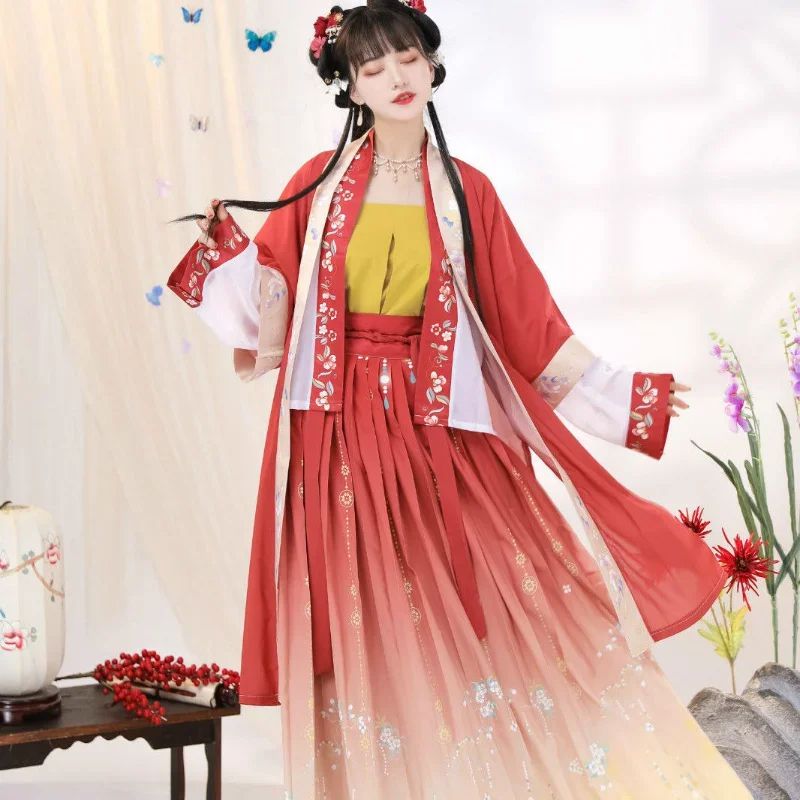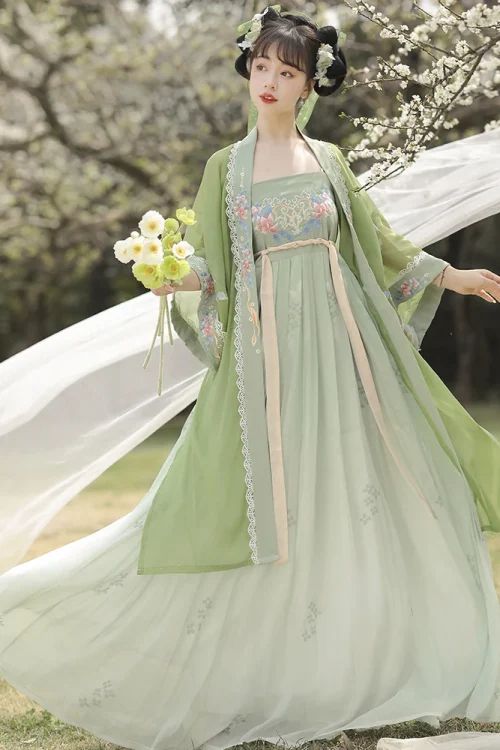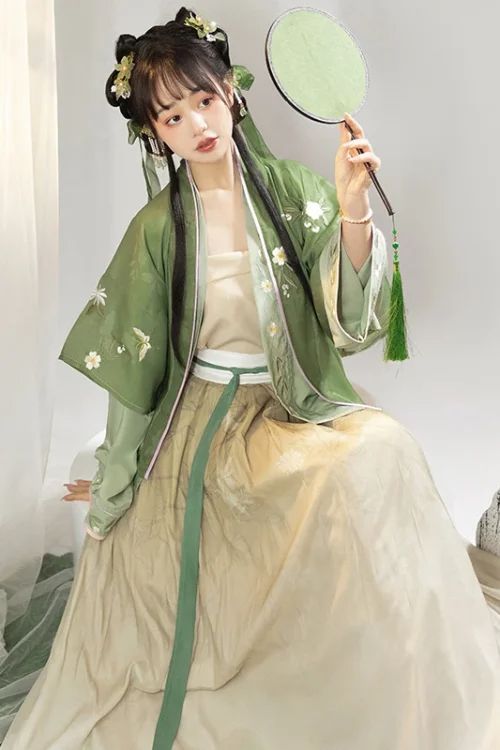The Flowing Silhouettes: Exploring the Graceful Lines of Song Dynasty Hanfu
The Song Dynasty (960-1279) witnessed a remarkable flourishing of Chinese culture, influencing the realm of fashion. Song Dynasty Hanfu, the traditional clothing of the era, embodied an unparalleled elegance and sophistication that continues to captivate modern-day enthusiasts.

Characteristics of Hanfu Silhouettes
The silhouettes of Song Dynasty Hanfu were characterized by flowing lines and graceful curves. Women’s robes, known as ruqun, featured wide, loose sleeves that cascaded over the body, creating an ethereal and feminine effect. The skirts, often layered and adorned with intricate embroidery, added volume and movement to the ensemble.
Men’s Hanfu, while more structured, also exhibited a sense of fluidity. The changpao, a long robe worn by scholars and officials, had wide sleeves that narrowed at the wrists, creating a dynamic and elegant silhouette. A sash, known as a dai, accentuated the waistline and added formality.
Cultural and Social Significance
Beyond its aesthetic appeal, Song Dynasty Hanfu held significant cultural and social meaning. The choice of fabrics, colors, and patterns reflected the wearer’s status and occasion. Silk, a luxurious material, was reserved for the elite, while cotton and linen were more commonly worn by the masses.
The colors of Hanfu also carried symbolic meanings. Red, associated with joy and celebration, was often worn during festivals and weddings. Blue, representing tranquility and harmony, was favored by scholars and officials. Green, symbolizing nature and prosperity, was popular among the common people.
Symbolic Patterns
The patterns embroidered on Hanfu were not merely decorative but conveyed auspicious messages. Cranes represented longevity, while peonies symbolized wealth and prosperity. These motifs served as a form of nonverbal communication, expressing the wearer’s hopes and aspirations.
结论
In conclusion, the elegance of Song Dynasty Hanfu lies not only in its flowing silhouettes but also in its cultural and social significance. The choice of fabrics, colors, and patterns reflected the wearer’s status, occasion, and personal beliefs. As a testament to the enduring beauty and cultural heritage of China, Song Dynasty Hanfu continues to inspire and captivate fashion enthusiasts today.
Embroidered Masterpieces: Unveiling the Symbolism and Craftsmanship of Song Dynasty 汉服
The Song Dynasty (960-1279) witnessed a flourishing of Chinese culture, including the development of exquisite Hanfu, the traditional clothing of the Han Chinese. Song Dynasty Hanfu is renowned for its elegance, intricate embroidery, and profound symbolism.

Varied Styles Based on Status
The styles of Song Dynasty Hanfu varied depending on social status and occasion. Commoners wore simple garments made of hemp or cotton, while the elite adorned themselves in elaborate robes of silk and brocade. Women’s Hanfu typically featured long, flowing skirts and blouses with wide sleeves, while men’s Hanfu consisted of a robe and trousers.
Artistry in Embroidery
The embroidery on Song Dynasty Hanfu showcased the artisans’ skill and creativity. Motifs such as flowers, birds, animals, and auspicious symbols were meticulously stitched using various techniques. These motifs carried deep meanings, representing virtues, wishes, and blessings. For instance, the peony symbolized wealth and prosperity, while the crane represented longevity.
Color Significance
The colors of Song Dynasty Hanfu also held significance. Bright colors such as red and yellow were reserved for formal occasions, while more subdued colors like blue and green were worn for everyday use. The use of contrasting colors created a striking visual effect, highlighting the wearer’s status and style.
Social Communication Through Attire
Beyond aesthetic appeal, Song Dynasty Hanfu served as a form of social communication. The type of fabric, embroidery, and accessories worn conveyed information about the wearer’s age, gender, occupation, and social rank, allowing individuals to navigate social interactions and establish their place within the hierarchy.
结论
The elegance of Song Dynasty Hanfu extended beyond its visual beauty. Designed for comfort and functionality, the garments allowed for freedom of movement and adaptability to different climates. The use of natural materials like silk and cotton ensured breathability and comfort, while loose-fitting styles provided ample coverage.
In conclusion, Song Dynasty Hanfu represents the pinnacle of Chinese textile artistry and cultural expression. Its elegant styles, intricate embroidery, and profound symbolism reflect the sophistication and refinement of the era, continuing to inspire and captivate audiences today.
Cultural Legacy: The Enduring Influence of Song Dynasty Hanfu on Chinese Fashion
The Song Dynasty (960-1279) witnessed a remarkable flourishing of Chinese culture, including the development of exquisite and elegant Hanfu, the traditional clothing of the Han Chinese. Song Dynasty Hanfu embodied the refined aesthetics and cultural values of the era, leaving an enduring legacy on Chinese fashion.

Simplicity and Grace
One defining characteristic of Song Dynasty Hanfu was its simplicity and grace. Unlike the elaborate garments of previous dynasties, Song Hanfu emphasized clean lines, flowing fabrics, and subtle embellishments. The use of natural fibers like silk and cotton created a soft and ethereal effect, while the absence of excessive ornamentation allowed the wearer’s natural beauty to shine through.
Varied Styles for Women and Men
The styles of Song Dynasty Hanfu varied depending on social status and occasion. For women, the most common garment was the ruqun, a long, flowing skirt paired with a short jacket or bodice. The ruqun was often adorned with delicate embroidery or woven patterns, adding elegance to the otherwise simple silhouette. Men typically wore a long robe called a changpao, layered with a jacket or waistcoat for warmth, often made of fine silk or cotton with subtle patterns or embroidery.
Cultural Significance
Beyond its aesthetic appeal, Song Dynasty Hanfu held significant cultural importance. The clothing reflected Confucian values, emphasizing modesty, propriety, and social hierarchy. Different styles and fabrics denoted the wearer’s social status, with elaborate garments reserved for the elite and simpler ones for common people.
Impact on Later Fashion
The elegance and refinement of Song Dynasty Hanfu profoundly impacted subsequent Chinese fashion. The simple and flowing silhouettes became staples of later Hanfu styles, while the use of natural fibers and subtle embellishments remained hallmarks of Chinese clothing. The cultural significance of Hanfu as a symbol of Chinese identity and tradition continued to be passed down through generations.
Modern Revival
In recent years, there has been a resurgence of interest in Song Dynasty Hanfu, particularly among young Chinese people. This revival is driven by a desire to reconnect with traditional culture and appreciate the beauty and elegance of Hanfu. The popularity of Hanfu has also led to a vibrant community of designers and enthusiasts dedicated to preserving and promoting this ancient art form.
结论
The enduring influence of Song Dynasty Hanfu on Chinese fashion is a testament to its timeless beauty and cultural significance. The simple yet elegant silhouettes, the use of natural fibers, and the subtle embellishments contribute to the enduring appeal of Hanfu. As a symbol of Chinese identity and tradition, Hanfu continues to inspire and captivate generations of Chinese people, both in China and around the world.
